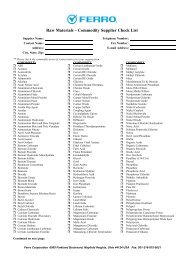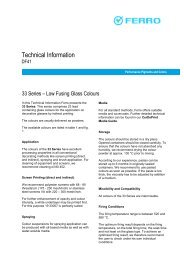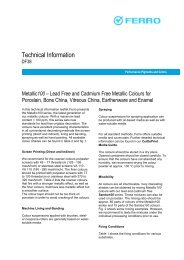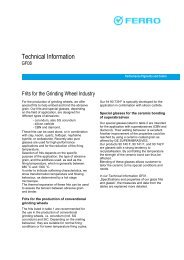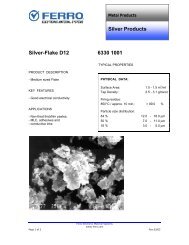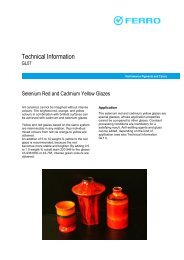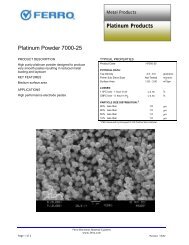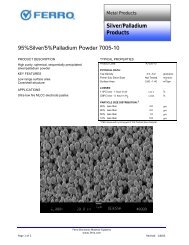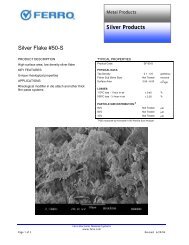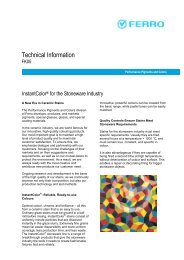LTCC PROCESSING INSTRUCTIONS For Ferro A6 and L8 Tape
LTCC PROCESSING INSTRUCTIONS For Ferro A6 and L8 Tape
LTCC PROCESSING INSTRUCTIONS For Ferro A6 and L8 Tape
You also want an ePaper? Increase the reach of your titles
YUMPU automatically turns print PDFs into web optimized ePapers that Google loves.
no metallization, etc. Only minimum pressure is used to laminate this dummy part to avoid any<br />
cavity distortion. With <strong>Ferro</strong> <strong>Tape</strong>, 1000 psi has typically been used.<br />
Once the dummy laminate has been prepared, the Silastic J is cast in the cavities <strong>and</strong> allowed<br />
to cure. After curing, the inserts are removed <strong>and</strong> cleaned <strong>and</strong> are then ready for use.<br />
Other materials that can be used for inserts are pieces of latex <strong>and</strong> other soft rubber. Latex<br />
must be accurately cut to size however.<br />
STEPPED WALLS<br />
It is important to underst<strong>and</strong> that a major problem can arise with stepped walls. This occurs if<br />
inserts are too stiff <strong>and</strong> do not compress enough during the lamination step. Consequently the<br />
steps can receive greater or lesser pressure than the bulk of the laminate <strong>and</strong> during firing<br />
shrink at a different rate.<br />
A similar effect can occur with cavity bottoms if a top plate is used on the registration fixture that<br />
over compresses Silastic J or latex.<br />
1.13 LAMINATION<br />
Lamination may be carried out in either isostatic or uniaxial laminators. However, lamination is<br />
critical in achieving consistent green density, <strong>and</strong> hence consistent shrinkage, hermeticity <strong>and</strong><br />
electrical performance, <strong>and</strong> <strong>Ferro</strong> strongly recommends the use of isostatic lamination, which<br />
has been demonstrated to give the most consistent results.<br />
Recommended lamination conditions are a pressure of 3000 psi, a temperature of 70°C with a<br />
10 minute dwell time –no pressure followed by a lamination time of 10 minutes.<br />
<strong>Ferro</strong> will provide Lamination Pressure vs. Lamination Density curves for each lot of <strong>Ferro</strong> <strong>Tape</strong><br />
as a reference guide for processing.<br />
1.14 BURN-OUT / FIRING<br />
Organic burn out may be combined with the firing operation in both box <strong>and</strong> tunnel furnaces, or<br />
may be performed as a separate step.<br />
The unfired laminates are heated, on their setters, at a rate of 2°C/minute to peak temperature<br />
of 450°C, which should be maintained for a minimum of 2 hours, to ensure complete<br />
combustion of all organics. This burn out procedure should be considered a starting point,<br />
although it should be more than adequate for most requirements; fine tuning of the burnout<br />
procedure will depend on part size, number of layers, <strong>and</strong> amount of metallization.



